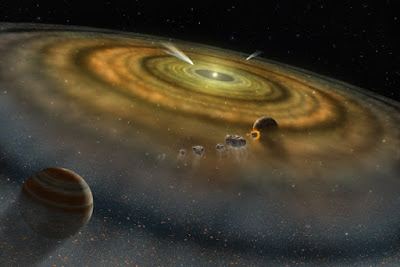Another Problem for Planetary Formation Speculations
As we have discussed on this site and referred to others, solar system formation ideas simply do not succeed. Several have been proposed, but the nebular hypothesis (accretion) seems to be less worse than the others, so they prop that up. After all, admitting that the evidence supports recent creation instead of deep time and cosmic evolution is unthinkable to secular cosmologists.
Even within the framework of the nebular hypothesis, you have the coherence of a goat rodeo. Not too long ago, secular scientists were claiming they had evidence that dust around stars will form into planets. (Strange how their presuppositions drive the narrative, and the possibility that dust around stars is a destructive process, and not from the formulation of planets.) On the other hand, the accretion concept is openly defying the laws of physics. To make matters worse for them, some of their own astronomers and physicists are also saying the nebular hypothesis won't work.
Excuses are freely made. Maybe the radio telescopes are incorrectly calibrated. No, wait! We know that accretion concept is absurd for our solar system, so maybe it works way out yonder! Yeah! (Reminds me of origin of life guesses. Since evolutionists cannot explain how life began here, then it happened elsewhere in the universe. C. Richard Dawkins believes that stuff, but the problem is still unsolved for secularists.) The way science is supposed to work is that when an idea cannot be supported, it gets put out to pasture. Not happening here, Zeke. I suspicion that they are too enamored of their materialistic philosophies to let it go and step into reality. It's nice here. And we have cookies.
 |
| Artist's conception of the dust and gas surrounding a newly formed planetary system. Image Credit: NASA (usage does not imply endorsement of site contents) |
Excuses are freely made. Maybe the radio telescopes are incorrectly calibrated. No, wait! We know that accretion concept is absurd for our solar system, so maybe it works way out yonder! Yeah! (Reminds me of origin of life guesses. Since evolutionists cannot explain how life began here, then it happened elsewhere in the universe. C. Richard Dawkins believes that stuff, but the problem is still unsolved for secularists.) The way science is supposed to work is that when an idea cannot be supported, it gets put out to pasture. Not happening here, Zeke. I suspicion that they are too enamored of their materialistic philosophies to let it go and step into reality. It's nice here. And we have cookies.
Secular scientists claim that stars form “naturally” from enormous clouds of gas and dust. The newly-formed star is thought to be encircled by a thin, slowly-spinning disk of dusty material. Dust particles within the disk are thought to collide and stick together, through a hypothetical process called accretion, somehow forming more massive clumps of matter over vast amounts of time. These clumps become the cores of future planets, and supposedly, the gravitational pulls of these clumps attract still more dust and gas, eventually forming planets. Despite the fact that this nebular hypothesis has become textbook orthodoxy, it has serious problems. Secular astronomers have recently uncovered what may be the biggest problem yet: these dust disks simply don’t have enough material in them to develop into planets!To read the rest, click on "Nebular Hypothesis Doesn't Hold Together". You may also like to see "Secular Miracles and the Origin of the Solar System".